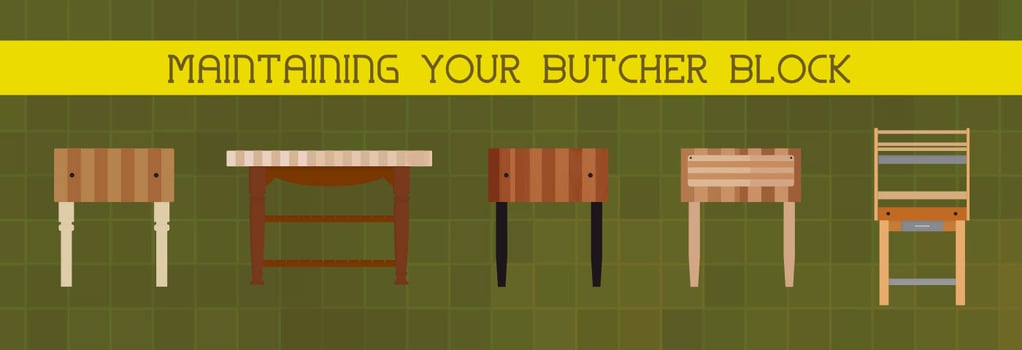A Guide to Butcher Block Care

No longer limited to the local meat shop, the butcher block is now a popular surface material for countertops, work tables, and cutting boards in commercial and residential kitchens. Those who use them value their natural wood appearance, sturdy nature, and durable construction. There are two different types of finishes that can be applied to butcher block surfaces, each requiring different care.
A sealed butcher block is finished with a lacquer, varnish, glaze, or other type of sealant, while an unsealed butcher block receives an oil finish. Although the sealed surface requires very little maintenance, it is not suitable for use as a work space or prep area for anything that involves knife work. The oil-finished butcher block requires regular maintenance, but can be used as a direct work space and withstand heavy-duty use. In addition to carrying out the following steps before using your butcher block for the first time, you should practice proper butcher block care to get the best results and longest life from your sealed or oil-finished butcher block surface.
Butcher Block Maintenance
To maintain proper sanitation, both sealed and oil-finished butcher block surfaces should be cleaned with hot water and mild soap after use. To avoid cross-contamination, dedicate one work space or cutting board to raw meats and another to vegetables and other ingredients.
If you are working with or cleaning a cutting board, you should never submerge or soak it in water or run it through the dishwasher, as this can cause the board to become waterlogged and warp. Although surfaces can be left to air dry, it is necessary to get rid of excess water with a clean paper towel, cloth towel, or rag. Moisture can severely damage butcher block surfaces, which is why it's important to maintain the surface's protection.
Sealed blocks don't need to be resealed unless the seal is damaged, which can happen if they are used as a cutting surface. However, oil-finished blocks rely on oil being reapplied to protect against moisture and bacteria and need to be re-oiled every few weeks or when the board shows signs of drying. Use the following oiling process for optimal butcher block care:
- Use a rag to apply an even coating of NSF-approved John Boos Mystery Oil or other cutting board oil to a clean, dry board. Although food grade mineral oil can be used, regular cooking oils should never be used, as they can become rancid and transfer flavors to your foods.
- Let the oil sit overnight, then remove any excess with a clean, dry rag or towel.
- If you are re-oiling a cutting board, do the top and sides first, then repeat the process to the bottom.
If dry spots persist after the surface has been re-oiled, you should repeat the process. You may also wish to further protect your butcher block with John Boos Block Cream, which can be applied using the same process.
References
Wood Countertops Pros and Cons. Sarah White, Chicago Mag. Published March 2012. Accessed December 2015.
Cleaning and Protecting Your Butcher Block Surface. B.E. Conrad, DoItYourself.com. Accessed December 2015.
John Boos Frequently Asked Questions. Accessed December 2015.

